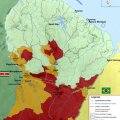AMAZONIAN PARK IN FRENCH GUIANA
The Amazonian Park of French Guiana is the largest national park in France and the European Union. Created in 2007, it covers an area of 3.4 million hectares in southern French Guiana, covering 40% of the territory. Located in the south-east of the Guyana Plateau and bordering Parque Nacional Montanhas do Tumucumaque in Brazil (3.9 million hectares - Amapa State), it also contributes to forming one of the largest protected areas in the world. Its highly original landscapes are complemented by a palette of rare environments: inselbergs (imposing rocky massifs) and forested mountains at altitudes of over 800 metres.
The national park is home to one of the planet's richest areas in terms of biodiversity, as well as a diversity and cultural originality that position these Amazonian territories as exceptional places to discover. The heart of the national park covers 2 million hectares. The "zone de libre adhésion" (1.4 million hectares) covers the catchment areas around its natural borders, the Oyapock River to the east and the Maroni River to the west. Five communes are included in the national park: Camopi, Maripasoula, Papaïchton, Saint-Élie and Saül, with a total population of over 15,000. It is home to the Amerindian populations (Apalaï, Tïlïo, Wayana, Wayãpi and Téko-Emérillon), the Black Maroons (Aluku/Boni) and the Creoles, as well as metropolitan populations and a few Hmong, Brazilians and Surinamese.
The Park's missions are to preserve the natural heritage, promote traditional cultures and support sustainable local development projects in consultation with local communities. The Etablissement public du parc amazonien de Guyane supports the emergence of an ecotourism industry.
Protecting the natural environment. Guiana's forests are a beacon of biodiversity on a global scale. Over 5,800 plant species have been recorded to date, including more than 1,500 tree species. The fauna includes 192 species of mammals, 260 species of reptiles and amphibians, 720 species of birds, 400 species of freshwater fish and hundreds of thousands of insects. This forest heritage is highly natural and in a good state of conservation, making it an ideal setting for knowledge and further scientific research into Amazonian ecosystems. The national park is home to some remarkable environments: rock savannas, inselbergs and forest mounts.
Preservation of cultural heritage and sustainable development. The aim is to preserve and promote the tangible and intangible cultures of the region's populations. Southern French Guiana has been home to nomadic Amerindians for several centuries, as well as to Black Maroons and Creoles since the second half of the 19th century. These traditional communities, with their rich cultural heritage, live to the rhythm of the rivers and rainforests, in close contact with nature. Their knowledge and know-how constitute a unique heritage, and intergenerational transmission is a key challenge.
Ecotourism. The Amazonian Park of French Guiana is committed to developing local, sustainable economic activities in consultation with the local population, and supports the emergence of an ecotourism industry through training, communication, development and equipment initiatives, with technical and financial support for project leaders.
Did you know? This review was written by our professional authors.
Book the Best Activities with Get Your Guide
Members' reviews on AMAZONIAN PARK IN FRENCH GUIANA
The ratings and reviews below reflect the subjective opinions of members and not the opinion of The Little Witty.

